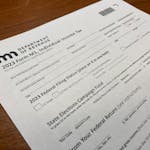Commuters dashing downtown to work last month used city-owned parking ramps at the highest rate since the pandemic began, according to new data released by the city of Minneapolis.
Municipal ramps were 35.4% full in October, marking the greatest use since downtown traffic nosedived with the arrival of COVID-19 in March 2020. If parking usage is an indicator of downtown vibrancy, Minneapolis has been on a steady climb back to its pre-pandemic self.
From February to April 2020, usage plunged from 77% to a measly 8% at the 15 ramps and eight surface lots owned by the city. But now fees collected for the city and three state-owned parking sites have crept back, bringing in $21.7 million so far this year. That's about 44% of the income produced in 2019 and 19% more than last year.
As more corporations recall workers to downtown offices or solidify hybrid work arrangements, parking ramp use is expected to keep rising.
"We would project numbers to continue to grow [...] into 2023," said Minneapolis Parking System Manager Tim Drew.
The parking ramp data dovetails with the rise in regional bus and train use reported by the Metropolitan Council for the first half of 2022. This summer, express bus ridership in the Twin Cities jumped 70% from the previous year, while Green Line and Blue Line light-rail ridership rose 25%.
At the same time, some highways are becoming congested at various times of day, suggesting business employees are back and jostling to get to or from work.
"Overall, transit is showing steady growth, up by 15% over the past year," said Metropolitan Council spokesman John Schadl. "September saw 3.8 million total trips, with an average of 141,000 weekday trips. This is the highest level since the beginning of the pandemic."
But post-pandemic commutes are shifting in other ways.
"We're finding that morning travel is lighter, while midday and evening commute times are heavier," Schadl said, as people scatter their work hours under hybrid work models.
The Met Council expects new commuter data and analysis to be released next week, Schadl said.
Minneapolis Downtown Council President Steve Cramer is pleased to see early numbers confirm what was predicted for the early days of fall.
The city is "definitely seeing a little of that post-Labor Day bump" as more companies strengthen their in-office strategies, Cramer said.
Last week, U.S. Bank CEO Andy Cecere asked employees to begin returning to their respective offices at least three days a week. Pre-pandemic, the bank boasted 4,582 employees in Minneapolis, according to Downtown Council records.
The Federal Reserve Bank of Minneapolis, Graco, Ameriprise, CenterPoint Energy and Deluxe Corp. have also asked employees to show up more to help re-establish office culture, employee collaborations and communication.
"Most of our employees are back at least three days a week downtown, some four days a week," said Cameron Potts, spokesman for Deluxe, which has 6,000 employees, including 425 who recently relocated to the new company headquarters in downtown Minneapolis.
"We have been pretty consistent for the past few months. We are encouraging our employees to be in the office more often than not for collaboration and connection. We are seeing a lot of momentum in that regard," Potts said. "I am [also] seeing a lot more people downtown. The skyways are busier, the parking lots a little fuller."
Office sector watchers expect the trend will continue, but note it may not be because workers want to stop working from home.
"If a recession bears out and the employment market weakens, employers believe they will be in a stronger position to require personnel to be in the office," said Colliers Managing Director and Market Leader Jeremy Jacobs in the newly released Twin Cities office market report for the third quarter.
"Many employers believe that a recession could accelerate a return to normal with respect to being in the office on a daily or near-daily basis. In fact, some large employers, particularly in finance, have begun requiring employees in four-days a week," said Colliers Research Analyst Jesse Tollison.
But with metro unemployment at just 2.6%, Tollison said, "Employees maintain an outsized voice concerning whether, when and where they will work in person."
Some employers insist they remain committed to allowing employees to choose where they work. Thrivent Financial, which built an airy, eight-story, 264,000-square-foot headquarters in Minneapolis in 2020, is sticking with the hybrid, flexible work environment it embraced this summer. "On average, we're seeing about a quarter of our team come into the office several days a week," said Thrivent spokeswoman Liz Erickson.
"Rather than requiring a set number of days people need to come into the office," Erickson said, "Thrivent's leaders are committed to this flexible approach as we strive to attract top talent and continue to sustain our high-performance culture."
Currently 60% of the workforce in downtown Minneapolis comes into the office at least once weekly, Colliers reports. In downtown St. Paul, it's around 30% to 35%. According to Colliers, the slow return has caused office landlords, investors and parking lot owners to "sweat it out."
Drew, who manages Minneapolis' parking system, said, "We are unsure how long it will take to equal 2019, pre-pandemic values in our municipal system," but that use is steadily rising.




